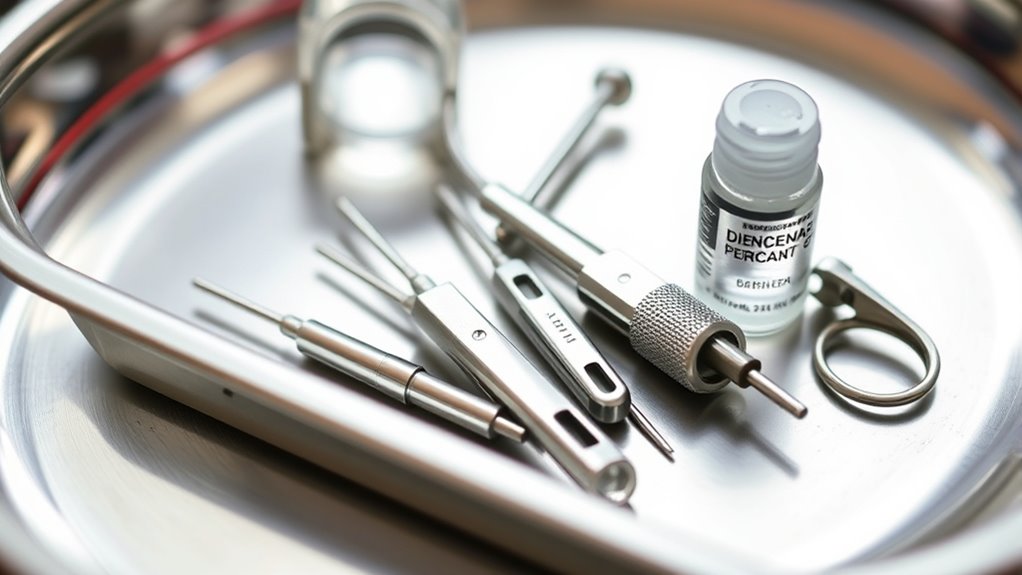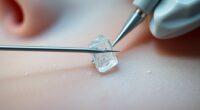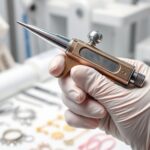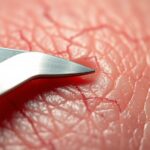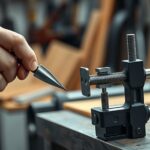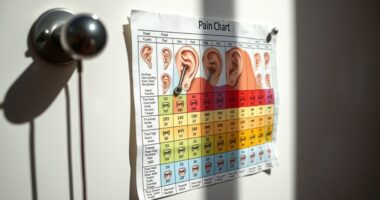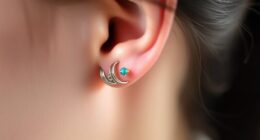Piercing tools like needles, clamps, and sterilization methods are essential for safe piercings. Needles are hollow, sterile, and single-use, ensuring precision and hygiene. Clamps hold tissue steady to minimize injury, while sterilization, often with autoclaves, removes bacteria and viruses from jewelry and tools. Using sterile equipment and strict safety procedures helps prevent infections. Want to understand how these tools work together for safe piercings? Keep exploring to discover more.
Key Takeaways
- Needles for piercing are hollow, pre-sterilized, single-use tools designed specifically for precise tissue penetration.
- Clamps stabilize tissue during piercing, reducing movement and injury risk with sterile, controlled gripping.
- Jewelry must be sterilized via autoclave before insertion to prevent infections and ensure safety.
- Sterilization equipment like autoclaves use high-pressure saturated steam to eliminate microorganisms from tools and jewelry.
- Maintaining a sterile environment with disposable barriers and proper hygiene practices is essential for safe piercing procedures.

Have you ever wondered what tools are essential for a safe and precise piercing procedure? The answer lies in understanding the critical equipment and protocols that ensure both your safety and the quality of the piercing. A professional piercer relies on specific tools like needles, clamps, and sterilization methods to perform each procedure accurately and hygienically. Jewelry sterilization is a vital step, as it guarantees that the jewelry you receive is free from bacteria, viruses, or any contaminants that could cause infection. Proper sterilization involves using autoclaves, which utilize high-pressure saturated steam to eliminate all microorganisms. This process is non-negotiable in piercing safety procedures, as it prevents the transmission of infections and ensures that the jewelry used is safe to wear immediately after the piercing.
The needles used in piercing are specially designed for the procedure, often pre-sterilized and single-use to prevent cross-contamination. Unlike sewing needles, piercing needles are hollow, allowing the jewelry to be inserted smoothly through the skin or cartilage. When you’re being pierced, the piercer carefully selects the right needle based on the location and type of jewelry, always prioritizing safety and precision. Clamps are another essential tool—they hold the tissue steady, minimizing movement and reducing the risk of injury. These clamps are sterile, designed to grip the skin lightly but firmly, giving the piercer full control during the process. Additionally, the sterilization of jewelry is crucial, as it guarantees that the jewelry you receive is free from bacteria, viruses, or any contaminants that could cause infection.
Piercing safety procedures extend beyond just sterilizing tools. They involve meticulous hand hygiene, wearing disposable gloves, and using sterile equipment for each client. The entire process is performed in a clean environment, often with disposable barriers and sterile drapes, to prevent any contamination. The piercer’s training emphasizes these safety procedures, recognizing that even a tiny lapse can lead to complications. Every step— from selecting the right needle to sterilizing jewelry and using proper clamps—ensures you receive a piercing that’s not only beautiful but also secure and free from infection.
Frequently Asked Questions
Are There Specific Tools for Different Types of Piercings?
Yes, there are specific piercing tool types designed for different piercings. You choose your tools based on the piercing location and type, guaranteeing precision and safety. Tool material options like surgical steel, titanium, or sterilized needles help prevent infections. Using the right tools for each piercing minimizes pain and tissue damage, making the process smoother. Always select tools suited for the particular piercing to ensure ideal results and safety.
How Do Piercing Tools Vary Across Professional Studios?
Did you know that over 70% of professional studios customize their piercing tools? You’ll find that piercing tool materials vary, with surgical-grade stainless steel being the most common for durability and safety. Many studios offer tool customization options, tailoring tools to specific piercings or artist preferences. This guarantees precision and hygiene, making each piercing as safe and personalized as possible. Your choice of tools directly impacts the quality of your piercing experience.
Are There Eco-Friendly or Biodegradable Piercing Tools Available?
Yes, eco-friendly piercing tools are available. You can choose biodegradable needles made from materials like bamboo or other sustainable options, reducing plastic waste. Additionally, eco-friendly clamps are designed to be reusable and made from sustainable materials, minimizing environmental impact. These options allow you to get pierced responsibly while supporting environmentally conscious practices in professional studios. Always verify these tools meet safety standards for a safe and eco-conscious piercing experience.
What Are the Most Common Mistakes When Sterilizing Piercing Tools?
You should watch out for sterilization errors like not properly cleaning tools before sterilizing, which can leave contaminants behind. Avoid skipping steps in the process, such as failing to use the correct sterilization method or neglecting to check sterilizer indicators. These mistakes increase cross-contamination risks, potentially transmitting infections. Always follow strict sterilization protocols to guarantee tools are safe and sterile, protecting both clients and yourself from health hazards.
Can DIY Piercing Tools Be Safely Used at Home?
Like a sword in a blacksmith’s fire, your DIY piercing tools demand strength and precision. While you might think they’re durable enough, DIY safety risks lurk if tools aren’t properly sterilized and crafted. Using homemade tools can lead to infections or complications. For safe piercing, trust professional-grade tools and sterilization methods. Your health and safety should always be the strongest shield, not a gamble with makeshift equipment.
Conclusion
Now that you understand the different piercing tools, you’re better equipped to make informed choices and prioritize safety. Think of these tools as the conductor’s baton in a symphony—each one plays a essential role in creating a beautiful, harmonious result. By using needles, clamps, and sterilization properly, you guarantee your piercing journey remains smooth and safe, transforming a simple act into an artful dance of precision and care.

